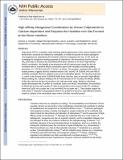| dc.contributor.author | Hayden, Joshua A. | |
| dc.contributor.author | Brophy, Megan Brunjes | |
| dc.contributor.author | Nolan, Elizabeth M. | |
| dc.contributor.author | Cunden, Lisa Stephanie | |
| dc.date.accessioned | 2014-01-27T15:54:00Z | |
| dc.date.available | 2014-01-27T15:54:00Z | |
| dc.date.issued | 2012-12 | |
| dc.date.submitted | 2012-09 | |
| dc.identifier.issn | 0002-7863 | |
| dc.identifier.issn | 1520-5126 | |
| dc.identifier.uri | http://hdl.handle.net/1721.1/84558 | |
| dc.description.abstract | Calprotectin (CP) is a transition metal-chelating antimicrobial protein of the calcium-binding S100 family that is produced and released by neutrophils. It inhibits the growth of various pathogenic microorganisms by sequestering the transition metal ions manganese and zinc. In this work, we investigate the manganese-binding properties of CP. We demonstrate that the unusual His[subscript 4] motif (site 2) formed at the S100A8/S100A9 dimer interface is the site of high-affinity Mn(II) coordination. We identify a low-temperature Mn(II) spectroscopic signal for this site consistent with an octahedral Mn(II) coordination sphere with simulated zero-field splitting parameters D = 270 MHz and E/D = 0.30 (E = 81 MHz). This analysis, combined with studies of mutant proteins, suggests that four histidine residues (H17 and H27 of S100A8; H91 and H95 of S100A9) coordinate Mn(II) in addition to two as-yet unidentified ligands. The His[subscript 3]Asp motif (site 1), which is also formed at the S100A8/S100A9 dimer interface, does not provide a high-affinity Mn(II) binding site. Calcium binding to the EF-hand domains of CP increases the Mn(II) affinity of the His[subscript 4] site from the low-micromolar to the mid-nanomolar range. Metal-ion selectivity studies demonstrate that CP prefers to coordinate Zn(II) over Mn(II). Nevertheless, the specificity of Mn(II) for the His[subscript 4] site provides CP with the propensity to form mixed Zn:Mn:CP complexes where one Zn(II) ion occupies site 1 and one Mn(II) ion occupies site 2. These studies support the notion that CP responds to physiological calcium ion gradients to become a high-affinity transition metal ion chelator in the extracellular space where it inhibits microbial growth. | en_US |
| dc.description.sponsorship | Kinship Foundation. Searle Scholars Program | en_US |
| dc.description.sponsorship | Massachusetts Institute of Technology. Center for Environmental Health Sciences (NIH P30-ES002109) | en_US |
| dc.description.sponsorship | Massachusetts Institute of Technology. Dept. of Chemistry | en_US |
| dc.description.sponsorship | National Science Foundation (U.S.) (Grant NSF-0070319) | en_US |
| dc.description.sponsorship | National Institutes of Health (U.S.) (Grant NIH GM68762) | en_US |
| dc.language.iso | en_US | |
| dc.publisher | American Chemical Society (ACS) | en_US |
| dc.relation.isversionof | http://dx.doi.org/10.1021/ja3096416 | en_US |
| dc.rights | Creative Commons Attribution-Noncommercial-Share Alike 3.0 | en_US |
| dc.rights.uri | http://creativecommons.org/licenses/by-nc-sa/3.0/ | en_US |
| dc.source | PMC | en_US |
| dc.title | High-Affinity Manganese Coordination by Human Calprotectin Is Calcium-Dependent and Requires the Histidine-Rich Site Formed at the Dimer Interface | en_US |
| dc.type | Article | en_US |
| dc.identifier.citation | Hayden, Joshua A., Megan Brunjes Brophy, Lisa S. Cunden, and Elizabeth M. Nolan. “High-Affinity Manganese Coordination by Human Calprotectin Is Calcium-Dependent and Requires the Histidine-Rich Site Formed at the Dimer Interface.” Journal of the American Chemical Society 135, no. 2 (January 16, 2013): 775-787. | en_US |
| dc.contributor.department | Massachusetts Institute of Technology. Department of Chemistry | en_US |
| dc.contributor.mitauthor | Hayden, Joshua A. | en_US |
| dc.contributor.mitauthor | Brophy, Megan Brunjes | en_US |
| dc.contributor.mitauthor | Cunden, Lisa Stephanie | en_US |
| dc.contributor.mitauthor | Nolan, Elizabeth M. | en_US |
| dc.relation.journal | Journal of the American Chemical Society | en_US |
| dc.eprint.version | Author's final manuscript | en_US |
| dc.type.uri | http://purl.org/eprint/type/JournalArticle | en_US |
| eprint.status | http://purl.org/eprint/status/PeerReviewed | en_US |
| dspace.orderedauthors | Hayden, Joshua A.; Brophy, Megan Brunjes; Cunden, Lisa S.; Nolan, Elizabeth M. | en_US |
| dc.identifier.orcid | https://orcid.org/0000-0002-6153-8803 | |
| dc.identifier.orcid | https://orcid.org/0000-0002-1733-9874 | |
| mit.license | OPEN_ACCESS_POLICY | en_US |
| mit.metadata.status | Complete | |
